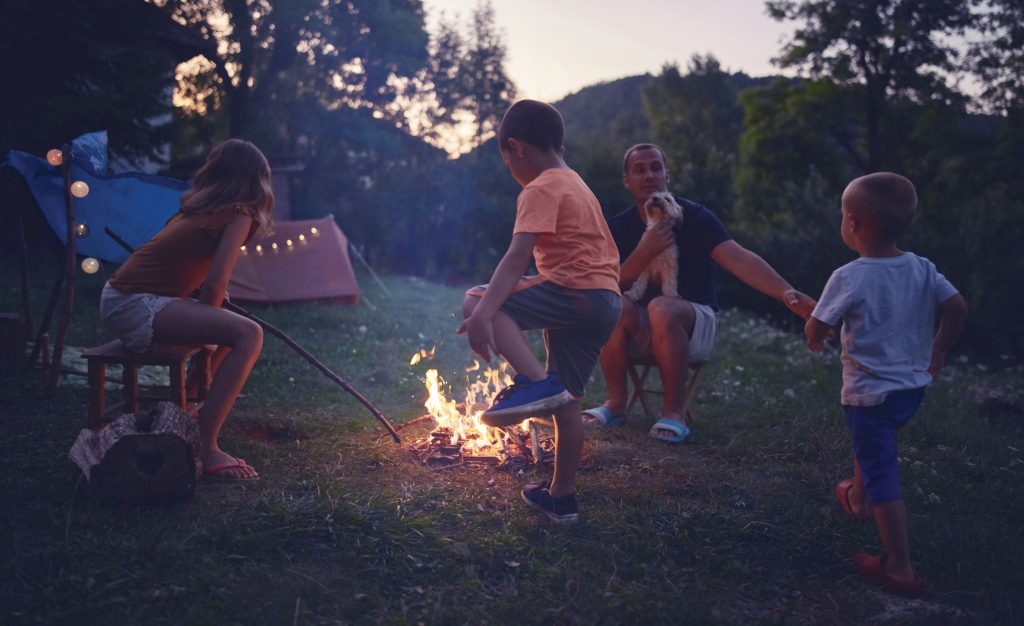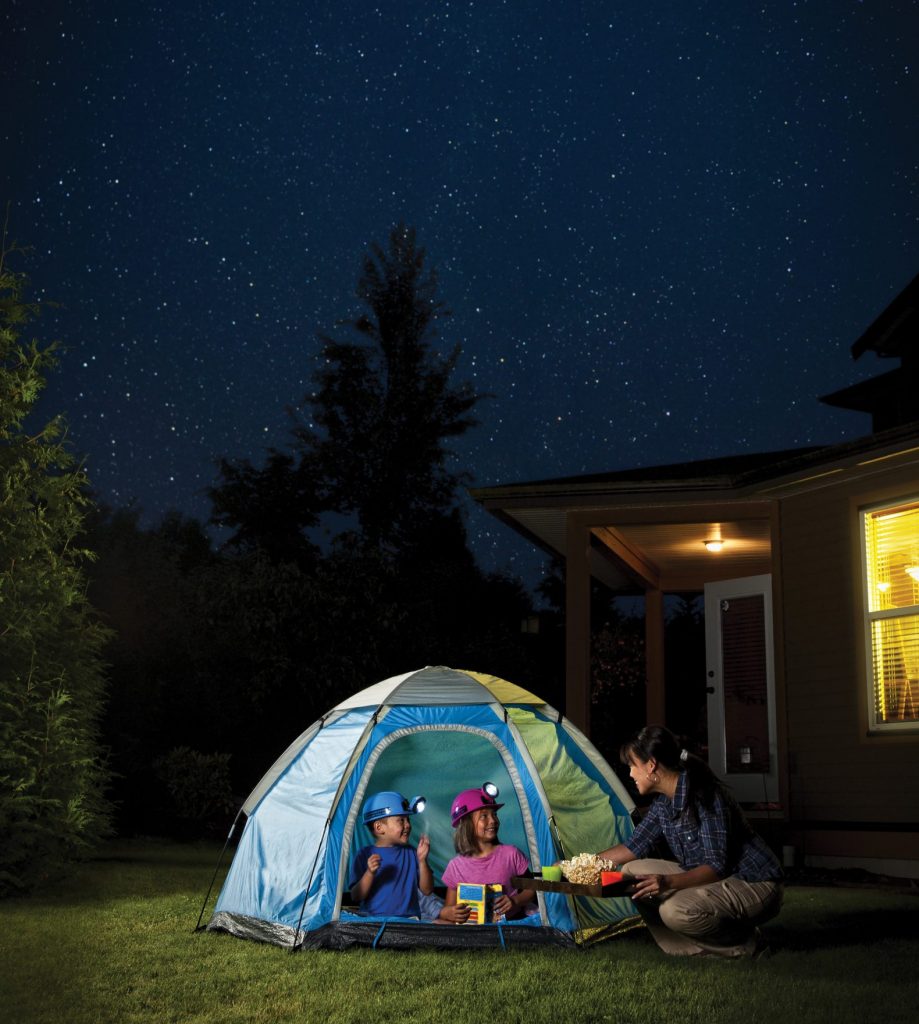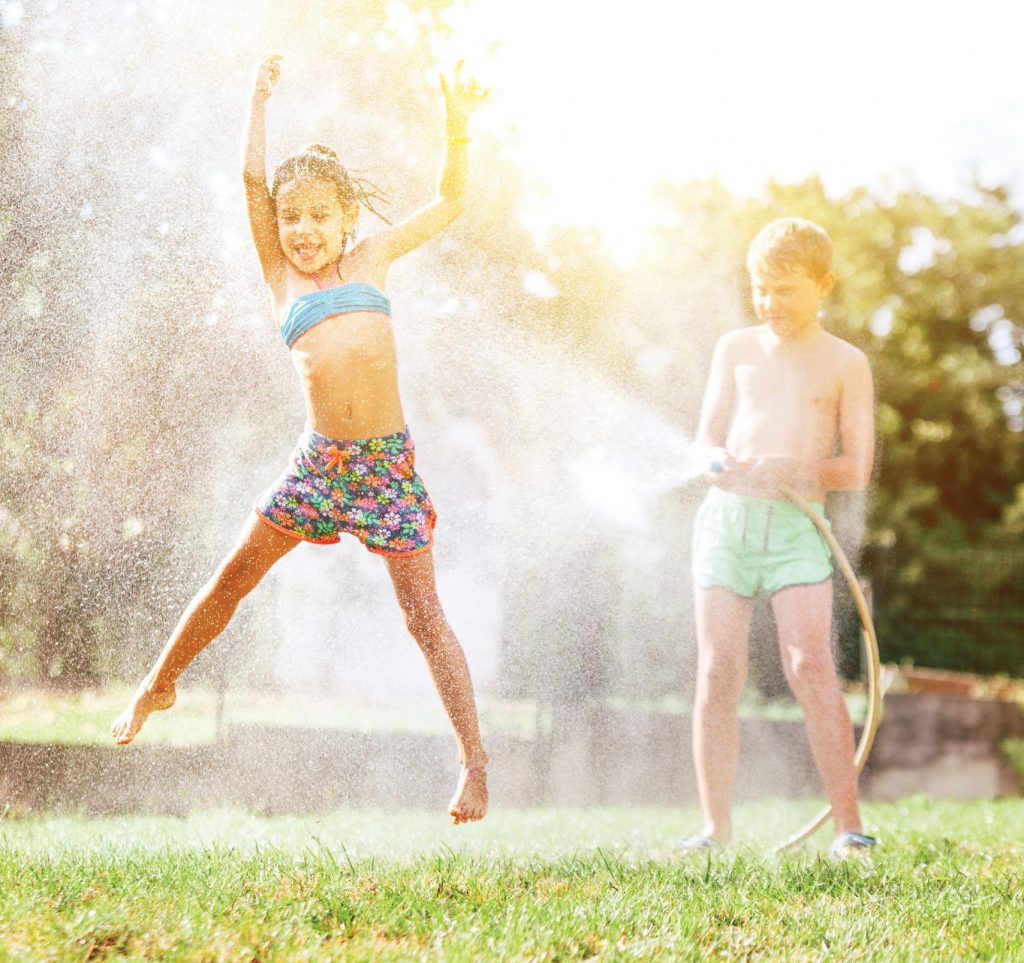
Leave it to Katie Hiatt, founder and managing editor of South Denver Moms, to sum up the season’s mood for families in one neat phrase: “Summer vacation! feels a lot more like ‘summer vacation.’” Hiatt shares tips, activities, events and more with more than 1,500 area parents and businesses through her resident arm of The Local Moms Network, an online resource for almost 300,000 families nationwide. The mother of two is dedicated to bettering family life. That’s why Hiatt and Cassidy Morris, camp director at kids camp outfit Avid4 Adventure, headquartered in Boulder, make a superb team for taking summer days at home to the next level. Get ready—the kids are going to love this.
PLAN THE BEST BACKYARD CAMPOUT EVER
1. Boost the campsite with a nontraditional tent. “If possible, hiring a company that specializes in setting up fun and festive tents for parties—who can set up in the backyard, basement, anywhere you want—will make the kids feel like they’re at sleepaway camp,” Hiatt says.
Or let the kids create an outdoor room with indoor blankets, pillows and beanbags.
“This isn’t everyday stuff: You’re not going to bring in one of those tent companies every week,” Hiatt says. “Kids see these activities as ‘oh we’re not doing normal everyday stuff’ and it gets them excited.”
2. Cook like you’re really camping. The more rustic and inventive the recipes—and the more you cook outside—the better. “It can feel intimidating to take on camping-style cooking with kids, especially young kids,” Morris says. “But from a life skills perspective, it’s a fun way to practice creativity and flexibility.
The Simple Main: Avid4’s 2 Bean Chili
INGREDIENTS
1 red and 1 green bell pepper
1 sweet potato
Handful of cherry tomatoes
Roughly 1 tablespoon oil
1 can pinto beans
1 can black beans
1 can corn
Onion flakes
Garlic powder
Cumin
Chili powder
Salt and pepper
Garnish with shredded cheese, cilantro and other favorite chili toppings
TOOLS FROM THE HOUSE
Large pot
Mixing spoon
Knives and cutting board
Camp stove
METHOD
Chop bell peppers and sweet potato into small pieces. If you prefer, cut tomatoes in half. Heat oil in a pot on medium heat and toss in peppers. Cook for about two minutes, stirring occasionally. Add everything except garnishes to the pot with whatever ratio of spices you prefer. Cook until sweet potato pieces are soft. If chili looks too thick, add water and adjust seasonings as needed. Serve with toppings.
S’mores 2.0: Crȇpes & S’mores
Courtesy the Dia sisters behind Le French; makes about 12 crêpes
INGREDIENTS
2 cups milk
1 cup unbleached all-purpose flour (or favorite gluten-free variation)
4 eggs, lightly beaten
2 teaspoons vanilla extract
2 teaspoons lemon zest
1 tablespoon granulated sugar
½ teaspoon salt
Butter (for cooking)
Graham crackers, chocolate squares and roasted or unroasted marshmallows
Choice of fillings: chocolate sauce, roasted peanuts, fruit spread, fresh fruit, etc.
TOOLS FROM THE HOUSE
Large bowl
Whisk
Crêpe pan or small, nonstick sauté pan
Small ladle
Camp stove
METHOD
In a large bowl, whisk together milk and flour until batter is smooth and lump-free. Add eggs, vanilla, lemon zest, sugar and salt. Whisk until smooth. Heat pan over medium heat and grease with a small amount of butter. Spoon about one ladle’s worth of batter into the hot pan, tilting the pan so the bottom surface is evenly coated with batter. Cook over medium
heat for about two minutes until golden. Flip crêpe and cook for about one minute. Repeat.
Once cooked, re-place crêpes in the pan at low heat. On only half of a crêpe, spread your sauce of choice, sprinkle with fruits or peanuts and layer graham crackers, chocolate pieces and marshmallows. Fold crêpe in half like a quesadilla. Flip, cooking until chocolate and marshmallow(s) melt. Plate, cut into triangles and sprinkle with powdered sugar.
Can we roast marshmallows over a gas firepit?
Most enthusiasts and experts say absolutely! The propane or natural gas used in firepits is the same fuel that powers barbecue grills. It should be noted, however, that gas firepits are not typically considered or safety-tested as cooking appliances.
Do be sure the family knows to be extra careful while roasting: Instead of gooey marshmallow drips getting burned away, the bits will stick to your faux logs or glass—your firepit media—and/or burner. If enough of those gather, the drippings could impede your firepit’s system and become extremely difficult to clean. So, keep watch while roasting and clean your
burner and media often.
3. Stargaze like an astronomer—with these insightful apps. To get going, just aim for the stars with your device camera: each curates a real-time view of the sky pinpointed by your location. The more you explore the apps, the
more benefits you’ll get—like views of the sky at different moments in time (past or future) and images of deep-sky objects.
STAR WALK 2
Available on iOS and Android
The kids will love: the “Visible Tonight” section, which lists upcoming sightings from your location, and the app’s atmospheric sound effects.
SKYVIEW LITE
Available on iOS and Android
The kids will love: following the sun and moon to their exact locations.
STAR CHART
Available on iOS and Android
The kids will love: learning what the sky looks like on the other side of the world—simply point your camera toward the ground.

“Camping at home can be an awesome way to prepare for camping in remote areas in the future. Go through all the things you would think about as if you were actually in the wilderness: making sure you find a flat, smooth spot for your tent, checking the weather, maybe having a discussion on what animals you might see.” –Cassidy Morris
MAKE YOUR OWN ART STUDIO
The supplies you’ll need for these projects: flour, water, shaving cream, food coloring, dish soap, bowls or gallon freezer bags, condiment bottles, toothpicks, straws, paper and markers, crayons or colored pencils.
–Concoct Puffy Sidewalk Paint–
“I liked puffy paint as a kid and my 3 ½-year-old daughter, Willa, is sometimes finicky about chalk dust,” says Hiatt, who also has a 10-month-old son, Elliot.
INGREDIENTS AND TOOLS
1 cup flour
1 cup water
½ cup shaving cream
Food coloring
Gallon freezer bags or bowls
Condiment bottles
Toothpicks
METHOD
Combine flour, water and shaving cream. Divide mixture into freezer bags or bowls. Add food coloring to each (as much as you’d like) and mix, making sure there are no clumps. Cut one corner of each bag and squeeze, or carefully pour from bowls, into empty condiment bottles. Secure bottle tops, and paint! Toothpicks help reopen bottle tops if anything clumps later.
–“Paint” Bubble Prints-
“My mother-in-law is a teacher and sometimes gives us teaching books and magazines. This activity came from one of those,” Hiatt says. “It makes the coolest pictures: My daughter’s looks like something you might actually hang in the house.”
INGREDIENTS AND TOOLS
1 teaspoon food coloring per color
½ cup water per color
2 tablespoons dish soap per color
Straws
Paper
METHOD
Combine food coloring, water and dish soap. Have the kids dip straws into the mixture(s) and blow bubbles onto paper.
–Mindful moment: Sound Map–
How Morris frames mindful activities: “I like to think of our minds as puppies,” she explains in a recent video Avid4 shared with virtual campers. “Puppies get really excited and sometimes have a hard time focusing. Sometimes that’s our minds: We get distracted. And we don’t want to get mad at ourselves—we wouldn’t get mad at the dog. We just want to remind our minds to be present and focus on what’s happening right now.”
TOOLS
Markers, crayons or colored pencils
Paper
METHOD
Have the kids draw themselves as stick figures in the center of a piece of paper. Set a timer for a few minutes and tell them to quietly listen to the sounds around them. Whenever they hear a noise, they guess where around them that sound is coming from. Then, they draw the object making the sound within that area on their paper—using whatever color of crayon,
marker, etc. they feel best fits the noise.
If they hear a dog barking in front of them, for example, they draw a puppy toward the front of their paper (in front of their stick figure). They continue until time is up. Have the kids share their drawings and explain what they heard.
–Have teens around?–
Have them try splatter painting, Morris says.
1. Choose a “canvas” (like butcher paper) and an area in the backyard to paint in. Hang that piece of butcher paper between two trees or lay it on the ground, weighing down the corners.
2. Pick a splattering tool—a paintbrush, spray bottle, flyswatter, etc.
3. Fill containers with paint and enjoy.
Splatter painting steps courtesy School Specialty

SEND THEM ON TREASURE HUNTS
Outdoor and indoor obstacle courses and scavenger hunts are a blast, says Hiatt’s daughter Willa—and a number of other Local Moms Network kids. Routes and lists can be catered to any age group.
–Create an outdoor obstacle course-
☐ Plan your course: How elaborate will it be? What’s the finish line? “With younger kids, include up to four to five items,” Hiatt says. “Beyond five, my daughter is like, ‘what am I doing here?’”
☐ Pick your obstacles. Any outdoor playthings and movable, safe indoor items are fair game. “If you’re going to add a water element, you do need to be more cautious with the obstacles you include,” she adds. Hiatt has used a hula hoop, cones, baby pool and even an inflatable slide.
☐ Set a timer.
–Create an indoor obstacle course–
☐ Stock up on painter’s tape, which will create the route.
☐ Prepare the map. “Think about things kids can crawl through and step over, and stops they should make,” Hiatt says. “A lot of parents have done sections where kids have to turn around three times or do four jumping jacks. Allow them to go places or do things that they wouldn’t normally do, obviously thinking of safety first.” Indoor courses can be a little longer than outdoor courses.
☐ Set a timer.
–Now, on to scavenger hunts.–
“We’ve done outdoor versions my daughter completes on walks, but the other really fun way to do this—and is something my daughter just asked about today—is with an indoor hunt,” Hiatt says. Pick from the myriad of lists available online or make your own.
TRANSFORM CHORES
Fun ways to get the kids to (shhh) help you.
–Start a mini “car wash”–
In other words, create a fun way for the kids to wash their toys, bikes and more. “I took my kids’ toy food outside, put a ton of Dawn soap in a water table and had them—really, my daughter—wash that food,” Hiatt says. “My daughter had fun bubbly water to wash the toys in, she rinsed everything off in a big bucket of water and then she literally threw the toys onto towels
I’d laid out.” Baby pools, with proper supervision, work as well as water tables.
–Make them feel like movie stars–
When they’re dragging their feet to clean up a mess or, say, won’t eat dinner, turn the activity into a filming session. Turn your phone’s camera to time-lapse shooting mode, Hiatt says, and “let them go to town. … My daughter is a very picky eater, so one day I told her we were going to make a video of her eating, which we could watch when she was done. I propped my phone in front of her and she ate that entire meal. She loved watching the video back.”
-Race!–
“My first summer with Avid4, the camp leadership got instructors to pack more efficiently by doing a relay race,” Morris says. “There were different stations where we had to complete tasks we normally do at camp, but we had to do them really fast. Whether you’re doing this between siblings or you as the parent are challenging your kid, this will help them practice doing chores and give them a fun memory of doing chores.”
-Put them in charge–
Kids who have leadership roles, Avid4 has found, are a lot more enthusiastic about completing tasks. “For example, if we’re going on a hike, we’ll make someone the toastmaster, who reminds everyone to drink water,” Morris says. “If we’re climbing and someone is waiting their turn, we’ll ask them to be the rope wrangler. The kids get excited because they feel like they have a purpose.”
THE AVID4 DAILY ROUTINE
1. Start with the respect talk. Avid4 camp leaders begin a typical summer camp day/week outlining what kids need to do to be considerate. “We have the acronym Respect PONY,” says Morris. “Each letter stands for a piece of the respect puzzle: the P is property, the O is others, the N is nature—if we’re going on a hike we’re not picking flowers, for example—and the Y is yourself. This talk is brought up again if needed.”
2. Decide intentions with goal setting. “It’s kind of challenge by choice: going after challenges kids feel comfortable pursuing within activities that day.”
3. Debrief at the end of the day. “We give everyone a chance to reflect on their day—maybe talking about high points, maybe low points and then having them say something they’re looking forward to.”
4 WAYS TO HELP THE KIDS SLEEP BETTER AT NIGHT
Dr. Dawn Stanley, a sleep specialist based in Lone Tree’s Sky Ridge Medical Center, considers sleep a life skill. Now, in the midst of current constant change and stress, it’s even more important to focus on tips and ways to establish good sleeping patterns, she says.
1. Give kids a chance to talk about their day. “Sitting at the dinner table and talking about worries, things they are learning, etc. will help kids decompress,” Stanley says. “A lot of times we think, what do kids have to worry about? But their lives are being turned upside down just like ours.”
2. Stick to a consistent schedule. “Kids like to have something to look forward to and like to have a pattern—whether that’s dinner every night at 6 a or having family game night every Friday. Having these things to look forward to has been shown to reduce anxiety and stress, which will help them sleep at night.”
3. “Avoiding caffeine and stimulants, especially after dinner when possible, is really important.” Things like chocolate and juice boxes can have caffeine in them. Allergy medicine (like Sudafed and Benadryl) can create problems with anxiety and stress as well, Stanley says.
4. Prep a good sleep environment. In addition to creating a dark space, keeping the room cool, having a set bedtime routine and no blue light, “pillow talk for younger kids is important. Just be sure to set limits. … And don’t skip the story. Reading to your kids at bedtime has been shown to improve vocabulary and relax them.”
Pro tip: “Kids should not snore. Everyone snores every once and while because they have allergies or a cold, but if kids are regularly snoring, they should be evaluated. And kids should not be sleepy during the day—if they are something’s wrong. Ironically, kids get hyper when they don’t get enough sleep: Please don’t put kids on stimulant medications for ADHD until you evaluate their sleep.”
IF ALL ELSE FAILS, BRING SUMMER CAMP TO YOU
In addition to hosting small group adventures and an online camp, Avid4
Adventure summer camps can happen at or around home this season. “With Camp at Home, one instructor will be meeting a group of three to five kids at one of the parents’ homes for a week,” Morris says. “Parents privately register for the program, so they’ll know everyone going to the set
home ahead of time. The instructor will use some curriculum-based learning, but also just a lot of fun activities.”


